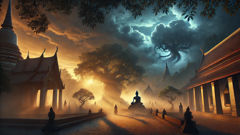Introduction
There’s a hush that lingers in the narrow sois of old Phra Khanong, a gentle melancholy that settles with the dusk and rises with the morning mist. Beneath tangled bougainvillea and the persistent hum of cicadas, locals still pause at the sight of a certain shrine—its golden roof gleaming faintly even under the cloudiest sky, its base heavy with garlands, incense, and humble offerings. Here, in the heart of modern Bangkok, ancient stories still breathe. Among them, none are as entwined with the city’s memory as the legend of Mae Nak. Her tale is whispered at riverside markets and relived in candlelit ceremonies, enduring for generations. It’s a story about love’s unwavering devotion, the ache of waiting, and the fragile line between the living and the dead. As the chao phraya river winds past wooden stilt houses and lotus ponds, it carries with it the echoes of Nak’s sorrow and hope—the devotion of a young bride who, even in death, refused to abandon her promise. The legend of Mae Nak Phra Khanong is more than a ghost story. It’s a portrait of enduring love, a reflection of Thailand’s spiritual heart, and a reminder that some bonds refuse to break—even as the world moves on.
The Promise Beneath the Banyan: Nak and Mak’s Beginnings
Long before Phra Khanong’s fields gave way to concrete and electric wires, the district was a patchwork of lush rice paddies, lotus ponds, and houses perched on wooden stilts above languid canals. In one such house, shaded by an ancient banyan tree whose roots curled like protective arms, lived a gentle young woman named Nak. She was known for her kindness, a melodic voice that soothed crying children, and eyes that seemed to hold the world’s longing. Her husband, Mak, was a simple farmer—broad-shouldered and earnest, with hands callused by years of labor and a heart that belonged wholly to Nak. Their love blossomed quietly, witnessed only by the slow-moving river and the whisper of monsoon winds. Each day, as the sun cast long shadows over the fields, Nak would prepare sweet rice treats for Mak to carry to work. The laughter of their courtship lingered in the air, bright and untroubled, even as their village nursed old superstitions about spirits lingering in the trees or riverbanks after nightfall. For Nak and Mak, though, the world seemed safe—bounded by the rhythm of seasons and the comfort of shared dreams. But the peace of Phra Khanong was brittle. The kingdom was restless, threatened by wars that called able-bodied men away from home. When Mak received his conscription order, he pressed Nak’s hands in his and promised, “No matter what, I’ll come back to you.” Nak, already heavy with child, tried to smile, her heart splintering. She watched him leave at dawn, his silhouette shrinking against the misty horizon. Days bled into weeks. Nak waited beneath the banyan each evening, singing lullabies to the unborn child and tracing the river’s curve as if it might deliver Mak back to her. News of the war arrived with the monsoon rains—stories of bravery and loss, but nothing certain of Mak. Yet Nak’s faith was unwavering. She believed that love alone could bridge the distances of war and fate. When at last Mak returned, worn but alive, he found Nak waiting for him on the house’s threshold, their child in her arms. Relief and joy swept through him, and for a time, their home was whole again. What Mak didn’t know—what no one dared say—was that Nak had died in childbirth and her spirit, bound by love, had refused to leave. The villagers, wary and tight-lipped, avoided their home after sunset, whispering prayers and clutching amulets. Still, for Mak, everything seemed unchanged. His beloved was as warm and gentle as before, their child thriving under her care. It was only when small oddities crept in—a pot lifted from across the room, Nak’s shadow flickering without reason, a chill that lingered after she sang at night—that Mak began to wonder. The legend of Mae Nak had only just begun to take shape.

Whispers in the Night: The Return and the Unveiling
Night in Phra Khanong carried a softness—crickets singing, the river’s slow song, and the faint scent of frangipani. Yet to the villagers, dusk became a time of wariness once Mak returned. Shadows seemed longer near his house, and dogs barked without cause. Mothers hurried their children indoors, and elders mumbled blessings as they passed. Inside, Mak clung to the life he’d lost and regained. Nak was unchanged in her affection—gentle hands tending to his wounds, laughter echoing through their stilted home. Their child, a boy with wide eyes, thrived in her presence. But the world outside grew restless. Neighbors recounted glimpses of Nak moving with unnatural swiftness, her silhouette shimmering in the moonlight. Someone claimed to see her reach for a dropped lime from the upper floor without bending—a feat impossible for the living. Rumors swirled, rising with the river fog. Mak dismissed them at first. Love, after all, can blind us to the impossible. He would watch Nak by lamplight, tracing her familiar smile and the gentle arc of her brow. But then came the dreams—fevered visions of Nak standing at the riverbank, her feet never touching the water, calling to him with a voice that echoed from somewhere far away. Mak’s unease deepened. When he confided in a monk at the village temple, he was met with grave silence. “There are spirits that cannot rest,” the monk said, offering Mak a blessed amulet and instructions for a protective ritual. Still, Mak hesitated to believe. One night, a storm battered their home, lightning illuminating the world in stark flashes. As Mak comforted his frightened son, he caught sight of Nak standing at the window, her form pale and translucent against the rain. For a moment, their eyes met—his full of terror, hers brimming with grief. The truth settled like a stone in his chest. Nak’s love had tethered her to the world of the living, even as her body belonged to the earth. In the days that followed, Mak’s sorrow grew heavier. He longed for his wife’s warmth but recoiled from the knowledge that she was no longer among the living. His child clung to Nak, never understanding the chill that followed her touch. As the lines between love and fear blurred, Mak faced an impossible decision: accept the comfort of a spirit or risk the wrath of a love that refused to let go. The villagers watched from afar, their fear matched only by pity for the young family caught between two worlds. And as the legend spread, Mae Nak’s name became a warning and a lament—a reminder that some promises can bind us even beyond death.

Conclusion
The story of Mae Nak Phra Khanong endures not because it frightens, but because it resonates with those who know the ache of longing and the strength of devotion. Even as Bangkok has grown and Phra Khanong’s fields have vanished beneath concrete and neon, locals and visitors alike pay their respects at her shrine, seeking blessings in matters of love and family. The legend is retold in films, plays, and whispered prayers—its shape evolving with each new generation, yet its heart remaining unchanged. Mae Nak’s story is a reflection of Thailand’s reverence for spirits, the importance of honoring promises, and the belief that love—no matter how fierce—must eventually let go. Her tale lingers in the early morning mist, in the scent of incense curling around banyan roots, and in the silent hope that love can heal even the deepest wounds. For those who pause at her shrine or dream beneath the monsoon sky, Mae Nak is both a warning and a comfort: love endures, but peace comes only with acceptance. In Phra Khanong, her devotion is immortal—a gentle presence guiding the living, and a timeless whisper between worlds.













